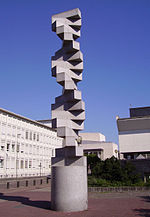BASF

BASF SE (German pronunciation: [beːaːɛsˈʔɛf] ), an initialism of its original name Badische Anilin- und Sodafabrik (German for 'Baden Aniline and Soda Factory'), is a European multinational company and the largest chemical producer in the world. Its headquarters are located in Ludwigshafen, Germany. BASF comprises subsidiaries and joint ventures in more than 80 countries, operating six integrated production sites and 390 other production sites across Europe, Asia, Australia, the Americas and Africa. BASF has customers in over 190 countries and supplies products to a wide variety of industries. Despite its size and global presence, BASF has received relatively little public attention since it abandoned the manufacture and sale of BASF-branded consumer electronics products in the 1990s.The company began as a dye manufacturer in 1865. One of its employees, Fritz Haber, worked with Carl Bosch to invent the Haber-Bosch process by 1912, after which the company grew rapidly. In 1925, the company merged with several other German chemical companies to become the chemicals conglomerate IG Farben. IG Farben would go on to play a major role in the economy of Nazi Germany. It extensively employed forced and slave labor during the Nazi period, and produced the notorious Zyklon B chemical used in The Holocaust. IG Farben was disestablished by the Allies in 1945. BASF was reconstituted from the remnants of IG Farben in 1952. It was part of the German economic miracle, and has since expanded considerably. It has received modern criticism for its poor environmental record.At the end of 2019, the company employed 117,628 people, with over 54,000 in Germany. In 2019, BASF posted sales of €59.3 billion and income from operations before special items of about €4.5 billion. Between 1990 and 2005, the company invested €5.6 billion in Asia, specifically in sites near Nanjing and Shanghai in China and Mangalore in India. BASF is listed on the Frankfurt Stock Exchange, London Stock Exchange, and Zurich Stock Exchange. The company delisted its ADR from the New York Stock Exchange in September 2007. The company is a component of the Euro Stoxx 50 stock market index.
Excerpt from the Wikipedia article BASF (License: CC BY-SA 3.0, Authors, Images).BASF
Carl-Bosch-Straße, Ludwigshafen am Rhein
Geographical coordinates (GPS) Address Website Nearby Places Show on map
Geographical coordinates (GPS)
| Latitude | Longitude |
|---|---|
| N 49.496111111111 ° | E 8.4311111111111 ° |
Address
BASF Besucherzentrum
Carl-Bosch-Straße
67063 Ludwigshafen am Rhein
Rhineland-Palatinate, Germany
Open on Google Maps










